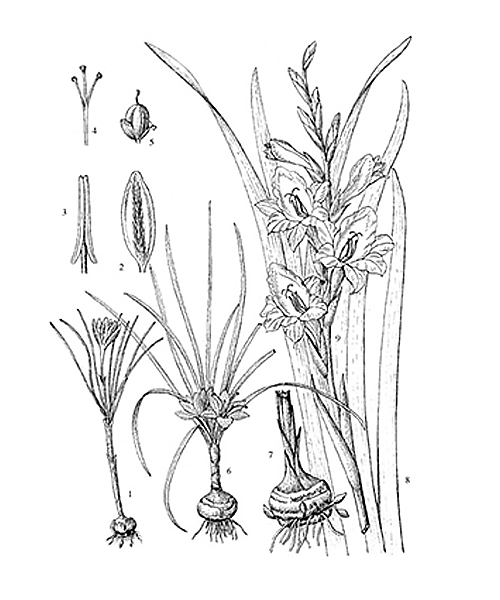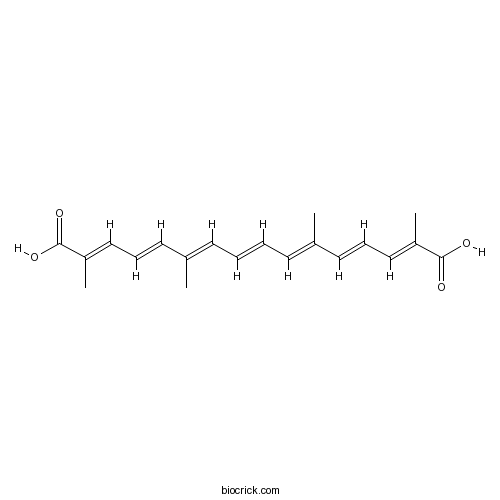Crocus sativus
Crocus sativus
1. The products in our compound library are selected from thousands of unique natural products; 2. It has the characteristics of diverse structure, diverse sources and wide coverage of activities; 3. Provide information on the activity of products from major journals, patents and research reports around the world, providing theoretical direction and research basis for further research and screening; 4. Free combination according to the type, source, target and disease of natural product; 5. The compound powder is placed in a covered tube and then discharged into a 10 x 10 cryostat; 6. Transport in ice pack or dry ice pack. Please store it at -20 °C as soon as possible after receiving the product, and use it as soon as possible after opening.

Natural products/compounds from Crocus sativus
- Cat.No. Product Name CAS Number COA
-
BCN3336
Kaempferol 3-O-beta-sophoroside19895-95-5
Instructions

-
BCN2372
Croceic acid27876-94-4
Instructions

-
BCN2373
Crocin42553-65-1
Instructions

-
BCN5549
Astragalin480-10-4
Instructions

-
BCN1027
Crocin II55750-84-0
Instructions

[Research progress of chemical components and pharmacological effects of non-medicinal parts of Crocus sativus].[Pubmed: 30111046]
The dried stigma of Crocus sativus (saffron) is a world&s precious spice and traditional medicine possessing plenty of pharmacological effects. Because the stigma represents only 7.4% of total weight of the fresh flower, when the stigma is separated from the flowers, large quantities of floral bio-residues are discarded. Accordingly, the utilization of the non-medicinal parts of saffron has drawn people&s attention. Studies showed that the non-medicinal parts of saffron were rich in flavonoids, phenolic acids, polysaccharides, et al. They were proved to have some pharmacological activities, such as antioxidant activity, antifungal activity, cytotoxicity, anti-inflammation and liver protection. The paper is to review the current research progress on the chemical components and pharmacological effects of the non-medicinal parts of saffron, which can serve as a reference for the further research and development of non-medicinal parts of saffron.
Transcript profiling of carotenoid/apocarotenoid biosynthesis genes during corm development of saffron (Crocus sativus L.).[Pubmed: 30078109]
The dried stigmas of saffron constitute the world's costliest spice. Saffron has many therapeutic applications due to the presence of apocarotenoids. The latter are synthesized at different stages of development, and the biosynthetic pathway involves several genes encoding different enzymes. In order to understand the differential expression of various genes of the pathway, eight distinct developmental stages (S1-early to S8-late) were identified. The corms were assorted into three groups (I, II, and III) based on corm weight. Expression profiles of 12 carotenoid/apocarotenoid genes were studied. The expression of all genes was minimum/least in groups I and II corms during bud development. Lowest expression of carotenogenic genes (CsPSY, CsPDS, CsZDS, CsCRTISO, CsLYC-β1, CsLYC-ε, CsBCH2, and CsNCED) was observed during early stages (S1-S3) of corm growth (dormant period). In group III corms, increased expression of apocarotenoid genes (CsZCO, CsCCD2, CsUGT, and CsALDH) was observed during S4 to S8 stages (reproductive period, floral differentiation). Besides, expression profiles of genes in apical and axillary buds were also examined. Of all the genes studied, apocarotenoid biosynthesis genes (CsBCH2, CsZCO, CsCCD2, CsALDH, and CsUGT) were found to be upregulated in apical bud than in the axillary bud. The results indicated that interaction of phytohormones and sugars, mother corm reserves and the influence of internal and external factors may be contributing to the growth of saffron corm/bud. The study has laid a foundation for further research on the molecular mechanisms underlying bud dormancy/growth in saffron.
Treatment with crocin improves cardiac dysfunction by normalizing autophagy and inhibiting apoptosis in STZ-induced diabetic cardiomyopathy.[Pubmed: 30017436]
The association of diabetes mellitus (DM) and poor metabolic control with high incidence of cardiovascular diseases is well established. The aim of this study was to investigate the potential cardioprotective effect of crocin (Crocus sativus L. extract) on diabetic heart dysfunction and to elucidate the mediating molecular mechanisms.
A Comparative Study on Anti-Invasion, Antimigration, and Antiadhesion Effects of the Bioactive Carotenoids of Saffron on 4T1 Breast Cancer Cells Through Their Effects on Wnt/β-Catenin Pathway Genes.[Pubmed: 29969282]
Crocus sativus L. (saffron) has been used as a spice and as a medicine for the past four thousand years. Recently, saffron has been well documented to possess anticancer effects on primary tumors. However studies of its antimetastatic potential are lacking. The present study is a comparative investigation of the antimetastatic effects of saffron carotenoids, crocin and crocetin, on triple negative metastatic breast cancer cells (4T1) and their effects on the Wnt/β-catenin pathway. It was found that treatment of 4T1 cells with crocin and crocetin resulted in the inhibition of viability in a dose-dependent manner. Scratch and Transwell chamber assays showed that the nontoxic doses of crocin and crocetin significantly inhibited migration, cell mobility, and invasion, also attenuating adhesion to extracellular matrix. Crocin downregulated mRNA expression of FZD7, NEDD9, VIM, and VEGF-α genes and upregulated E-CAD. Crocin and crocetin exhibited comparable anti-invasion properties on 4T1 cells. However, crocin and crocetin exerted more pronounced antimigration and antiadhesion potency, respectively. Furthermore, we showed that the antimetastatic effects of crocin can occur through interfering with the Wnt/β-catenin pathway.
Plant growth promoting bacteria associated with corm of Crocus sativus during three growth stages.[Pubmed: 29956836]
Corm, being a unit of reproduction and storage, plays an indispensable role in the life cycle of Crocus sativus (saffron). Present study deals with the screening of bacteria isolated from cormosphere (area surrounding the corm sheath) of Crocus sativus for biofertilizer and biocontrol property during three growth stages. Out of 1000 producing bacteria isolated from the cormosphere (soil adhering corm sheath in analogy to rhizosphere), 3 PGP Bacilli namely B. thuringiensis DC1, B. megaterium VC3 and B. amyloliquefaciens DC8 were selected based on multiple and maximum PGP traits along with corm rot pathogen antagonism. To evaluate in-vivo efficacy of the consortia, pot trials were conducted and a significant increase in number and length of both, shoot and root were observed. Further the disease incidence in test corms was reduced by threefold as compared to control and the number of daughter corms produced in pot trials was also increased. Since corm is a unit of reproduction/propagation, increase in its number is of major significance. This is the first report on isolation and characterization of PGPB from any cormosphere. This article is protected by copyright. All rights reserved.


